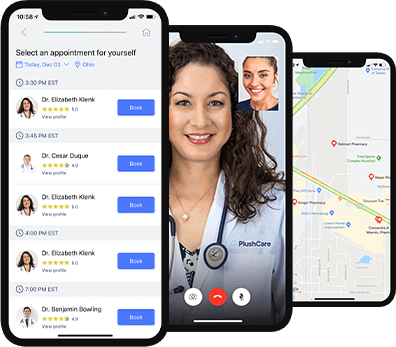Amoxicillin Rash: Signs, Side Effects, and Treatment
Can amoxicillin cause a rash? While most antibiotics have the potential to cause a rash, amoxicillin is more likely than most antibiotics to cause a rash.
Keep reading to find out more about what you can do if you experience an amoxicillin rash.
Book an appointmentWhat Is Amoxicillin?
Amoxicillin is an antibiotic in the penicillin family, and penicillin is a medication that many people are sensitive to.
What Is the Most Common Side Effect of Amoxicillin?
The most common side effects of amoxicillin include:
Rash
Vomiting
Diarrhea
Nausea
Headache
Changes in taste
Hives
Itching
Trouble breathing or swallowing
Swelling of the throat, lips, face, tongue, or eyes
Vaginal infection
Fever
What Are the Signs of an Allergic Reaction to Amoxicillin?
Signs of an allergic reaction to amoxicillin include:
Swelling of the throat, lips, face, tongue, or eyes
Hives
Trouble breathing
Amoxicillin Precautions
Despite its tendency to cause rashes, amoxicillin is generally safe. It is not right for everyone, and there are several factors you should keep in mind before taking it.
Antibiotics like amoxicillin can make hormonal birth control less effective. Talk to your doctor about whether you should use backup contraception such as condoms or a diaphragm.
Tell your doctor if you are breastfeeding, pregnant, or may become pregnant.
Always tell your doctor about your medical history and any medications you take. Especially be sure to mention if you have ever had:
Kidney disease
Diarrhea caused by antibiotics
Mononucleosis (also called "mono")
Food or drug allergies (especially to a cephalosporin antibiotic like Omnicef, Keflex, Cefzil, Ceftin, and others)
Frequently Asked Questions
What Does an Amoxicillin Rash Look Like?
An amoxicillin rash looks like flat, red patches on the skin (as opposed to hives, which are raised, itchy, red or white bumps). There are also usually smaller, paler patches along with the red patches.
An amoxicillin rash typically appears 3-10 days after starting amoxicillin, whereas hives caused by an allergic reaction to amoxicillin usually appear after the first or second dose.
How Do You Treat an Amoxicillin Rash?
Benadryl, an over-the-counter antihistamine, can help ease the itching of an amoxicillin rash or hives caused by an allergic reaction to amoxicillin. You should also talk to a doctor right away about whether or not to continue taking amoxicillin. Besure to ask your doctor if Benadryl is safe to take and tell your doctor about any prescription medications or over-the-counter medications you are taking.
Generally, you do not want to stop taking an antibiotic until you have taken the full course of treatment. However, allergic reactions can be serious and potentially fatal, so it is best to talk to a doctor if you develop a rash after taking amoxicillin.
How Long Does it Take for an Amoxicillin Rash to Go Away?
An amoxicillin rash usually clears up within a few days. If your rash does not go away after more than a few days, talk to your doctor.
Should You Stop Amoxicillin After a Rash?
It is best to talk to a doctor right away. Stopping antibiotics can lead to the development of antibiotic-resistant bacteria, but continuing to take amoxicillin if you are having a true allergic reaction could be dangerous. A doctor can tell you whether to continue taking the medication, or they can switch you to a different antibiotic.
Unless instructed otherwise (or you are having a serious allergic reaction), always take every antibiotic pill your doctor prescribes, even if you start feeling better or your symptoms go away. Failing to do so can contribute to the development of antibiotic-resistant bacteria and make it harder for you to fight off future infections.
When Should I Go to the Doctor for a Rash?
It is never a bad idea to talk to a doctor about your rash, but you should definitely seek medical attention if:
You have a fever
The rash is spreading
A rash covers your whole body
Your rash includes pus (a thick liquid that indicates infection)
The rash does not go away after a few days
You are experiencing additional symptoms

1
Book on our free mobile app or website.
Our doctors operate in all 50 states and same day appointments are available every 15 minutes.
2
See a doctor, get treatment and a prescription at your local pharmacy.
3
Use your health insurance just like you normally would to see your doctor.
Talk to a Doctor About an Amoxicillin Rash
If you have an amoxicillin rash, you should talk to a doctor immediately about whether to keep taking the medication. They may switch you to a different antibiotic, and they may be able to tell you whether you are experiencing a harmless amoxicillin rash or a potentially dangerous allergic reaction.
You do not have to visit your doctor’s office just for a rash. You can have an online video appointment with one of the licensed doctors at PlushCare.
You will show the online doctor the rash, tell them when it started, discuss your medical history (including why you were prescribed amoxicillin), and discuss any medications you take.
If appropriate, the physician can electronically send a prescription to your pharmacy for a different antibiotic or a topical medication to help reduce the itching.
To get started with PlushCare, you can book an appointment at a convenient time and learn what to do about your amoxicillin rash.
Read More About Amoxicillin Rashes
Sources:
PlushCare is dedicated to providing you with accurate and trustworthy health information.
National Institutes of Health. Immediate and non-immediate allergic reactions to amoxicillin present a diagnostic dilemma: a case series. Accessed on February 9, 2021 at https://www.ncbi.nlm.nih.gov/pmc/articles/PMC4717649/
Mayo Clinic. Penicillin Allergy. Accessed on February 9, 2021 at https://www.mayoclinic.org/diseases-conditions/penicillin-allergy/symptoms-causes/syc-20376222
Harvard Health Publishing. Do You Really Have a Penicillin Allergy? Accessed on February 9, 2021 at https://www.health.harvard.edu/blog/do-you-really-have-a-penicillin-allergy-2019022616017




